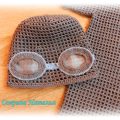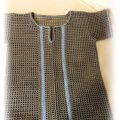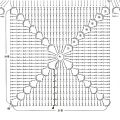
A socket surrounded by a grid in the form of a square
 The classic way of assembling Irish lace -laborious process and involves obesyvanie face down the motifs to the pattern with the further filling of the lumens with different types of nets. An untrained person will not be able to perform the canvas in such a way that there are no defects (tightening and folding). Therefore, a simpler path is possible, which involves the reverse sequence of the assembly: the motifs are sewn along the perimeter of the pre-fabricated mesh flaps. Formed small gaps filled with connecting motifs or sewed by the brides. Make it easier to assemble the squares. Composite Irish lace: the motif and the grid can be arranged in small fragments - circles, ovals, squares, which are much easier to assemble into larger canvases. We offer a scheme of square motif, which perfectly fits into the product in the technique of Irish lace. Of these motifs, you can link the whole or a cape.
The classic way of assembling Irish lace -laborious process and involves obesyvanie face down the motifs to the pattern with the further filling of the lumens with different types of nets. An untrained person will not be able to perform the canvas in such a way that there are no defects (tightening and folding). Therefore, a simpler path is possible, which involves the reverse sequence of the assembly: the motifs are sewn along the perimeter of the pre-fabricated mesh flaps. Formed small gaps filled with connecting motifs or sewed by the brides. Make it easier to assemble the squares. Composite Irish lace: the motif and the grid can be arranged in small fragments - circles, ovals, squares, which are much easier to assemble into larger canvases. We offer a scheme of square motif, which perfectly fits into the product in the technique of Irish lace. Of these motifs, you can link the whole or a cape.  The center is created by a rosette, the grid is knitted in 3 rows. 1st row: 1 st.p. for lifting, * 5pp, triple pico (hereinafter pico - 4vp, skipping 3pp of chain, make connection, 3v.p. ., co-ordinate in the previous connection, 3 vp and 1 more connection in the first connection), 6 bp, 1 stb. tie between the 4 th and 5 th pst. the next lobe of the last row of the outlet, 6 bp, 1 pico, 6 bp, 1 stb. on the top of the 1st st. the next petal, 6 bp, 1 pico, 6 bp, 1 st b. at the top of the last pst. The same petal. * From * to * repeat 3 times, the last chain of 5 vp. replace it with STSN., tie it into the lifting loop. 2nd row: * 5 bp, 1 pico, 5 bp, 1 ply. Art. tie it, grabbing a coin. Art. pico before. series, 6 cp, 1 cp. Art. for connection. Art. pico before. row, the work flip, under the arches of 6-tp. bind 1 st., 6 st.1n., 1 st., Turn over the work, on the tops of various-high st. tie in 1 st.b., flip the work, 6 bp, 1 st.b. fasten on the top of the 4th st. b., 6 vp, 1 stb. at the top of the 7th st century, 6 cp. and 1 st.B. on the top of the last st. Turn over the work, under the arches of 6-tp. bind 1 stb, 1 pst., 2 ct1s., 4 st2n., 2 st.1n., 1 st., 1 st. b., 3 cp. Art. for the edge loops of the columns before. rows of a dense element, 5 bp, 1 pico, 5 bp, 1 ply. Art. tie it, grabbing a coin. Art. pico before. * From * to * repeat 3 times, the last chain of 5 cp. replace it with std., tie it to the connection. Art. pico before. series. 3rd row: * 5 bp, 1 pico, 5 bp, 1 connection. Art. tie it, grabbing a coin. Art. pico before. series, 5 bp, 1 pico, 5 bp, 1 st bp. at the top of the 2nd st1n. 1st lobe of a dense element, 5 bp, 1 picos, 5 bp, 1 stb. on the top of the pst. The 2nd lobe of a dense element, 5 bp, 1 pico, 5 bp, 1 stb, at the top of the last pst. 2-nd petal, 5 bp, pico, 5 bp, 1 st b.p. at the top of the 4th st2n. 3-rd petal, 5 cp, pico, 5 cp, 1 cpd. Art. tie it, grabbing a coin. Art. pico before. * From * to * repeat 3 times, replacing the last chain of 5 cp. on sts., by tying it for a connection. Art. pico before. series. Source: "Duplet" magazine.
The center is created by a rosette, the grid is knitted in 3 rows. 1st row: 1 st.p. for lifting, * 5pp, triple pico (hereinafter pico - 4vp, skipping 3pp of chain, make connection, 3v.p. ., co-ordinate in the previous connection, 3 vp and 1 more connection in the first connection), 6 bp, 1 stb. tie between the 4 th and 5 th pst. the next lobe of the last row of the outlet, 6 bp, 1 pico, 6 bp, 1 stb. on the top of the 1st st. the next petal, 6 bp, 1 pico, 6 bp, 1 st b. at the top of the last pst. The same petal. * From * to * repeat 3 times, the last chain of 5 vp. replace it with STSN., tie it into the lifting loop. 2nd row: * 5 bp, 1 pico, 5 bp, 1 ply. Art. tie it, grabbing a coin. Art. pico before. series, 6 cp, 1 cp. Art. for connection. Art. pico before. row, the work flip, under the arches of 6-tp. bind 1 st., 6 st.1n., 1 st., Turn over the work, on the tops of various-high st. tie in 1 st.b., flip the work, 6 bp, 1 st.b. fasten on the top of the 4th st. b., 6 vp, 1 stb. at the top of the 7th st century, 6 cp. and 1 st.B. on the top of the last st. Turn over the work, under the arches of 6-tp. bind 1 stb, 1 pst., 2 ct1s., 4 st2n., 2 st.1n., 1 st., 1 st. b., 3 cp. Art. for the edge loops of the columns before. rows of a dense element, 5 bp, 1 pico, 5 bp, 1 ply. Art. tie it, grabbing a coin. Art. pico before. * From * to * repeat 3 times, the last chain of 5 cp. replace it with std., tie it to the connection. Art. pico before. series. 3rd row: * 5 bp, 1 pico, 5 bp, 1 connection. Art. tie it, grabbing a coin. Art. pico before. series, 5 bp, 1 pico, 5 bp, 1 st bp. at the top of the 2nd st1n. 1st lobe of a dense element, 5 bp, 1 picos, 5 bp, 1 stb. on the top of the pst. The 2nd lobe of a dense element, 5 bp, 1 pico, 5 bp, 1 stb, at the top of the last pst. 2-nd petal, 5 bp, pico, 5 bp, 1 st b.p. at the top of the 4th st2n. 3-rd petal, 5 cp, pico, 5 cp, 1 cpd. Art. tie it, grabbing a coin. Art. pico before. * From * to * repeat 3 times, replacing the last chain of 5 cp. on sts., by tying it for a connection. Art. pico before. series. Source: "Duplet" magazine.



